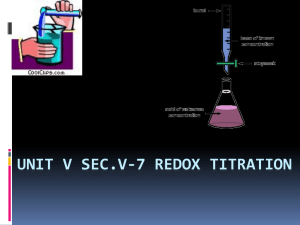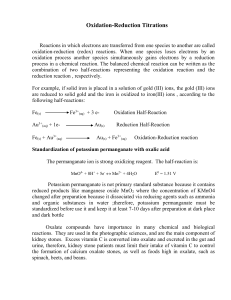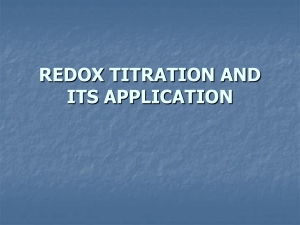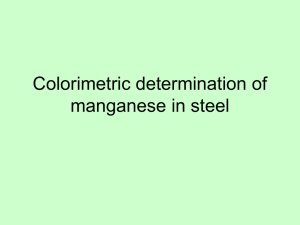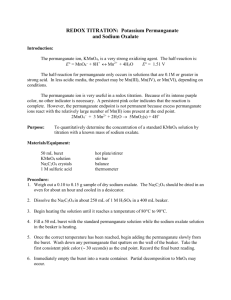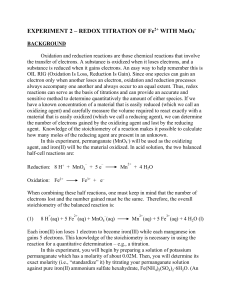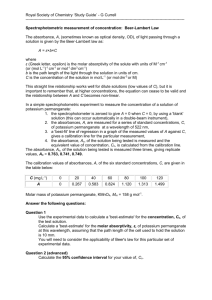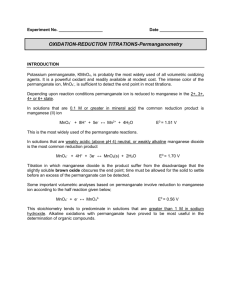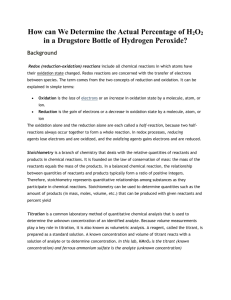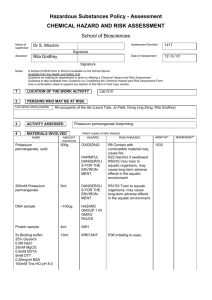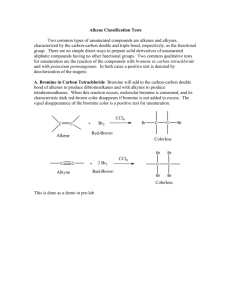Chemical Chameleon: Redox Reaction Lab
advertisement
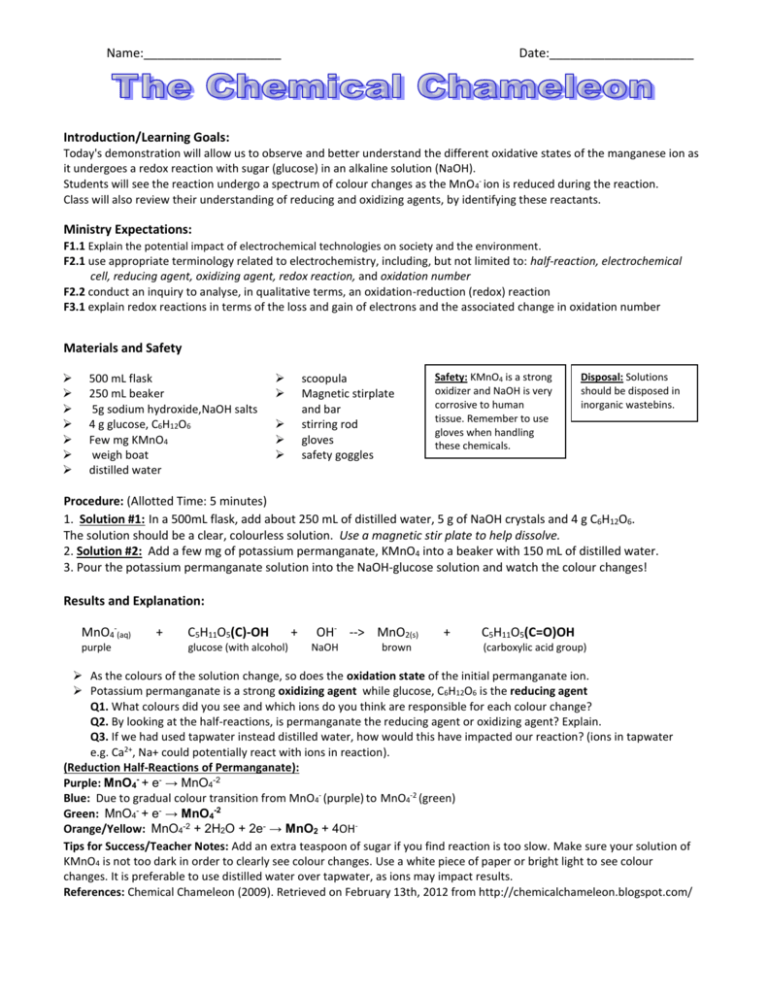
Name:____________________ Date:_____________________ Introduction/Learning Goals: Today's demonstration will allow us to observe and better understand the different oxidative states of the manganese ion as it undergoes a redox reaction with sugar (glucose) in an alkaline solution (NaOH). Students will see the reaction undergo a spectrum of colour changes as the MnO 4- ion is reduced during the reaction. Class will also review their understanding of reducing and oxidizing agents, by identifying these reactants. Ministry Expectations: F1.1 Explain the potential impact of electrochemical technologies on society and the environment. F2.1 use appropriate terminology related to electrochemistry, including, but not limited to: half-reaction, electrochemical cell, reducing agent, oxidizing agent, redox reaction, and oxidation number F2.2 conduct an inquiry to analyse, in qualitative terms, an oxidation-reduction (redox) reaction F3.1 explain redox reactions in terms of the loss and gain of electrons and the associated change in oxidation number Materials and Safety 500 mL flask 250 mL beaker 5g sodium hydroxide,NaOH salts 4 g glucose, C6H12O6 Few mg KMnO4 weigh boat distilled water scoopula Magnetic stirplate and bar stirring rod gloves safety goggles Safety: KMnO4 is a strong oxidizer and NaOH is very corrosive to human tissue. Remember to use gloves when handling these chemicals. Disposal: Solutions should be disposed in inorganic wastebins. Procedure: (Allotted Time: 5 minutes) 1. Solution #1: In a 500mL flask, add about 250 mL of distilled water, 5 g of NaOH crystals and 4 g C6H12O6. The solution should be a clear, colourless solution. Use a magnetic stir plate to help dissolve. 2. Solution #2: Add a few mg of potassium permanganate, KMnO4 into a beaker with 150 mL of distilled water. 3. Pour the potassium permanganate solution into the NaOH-glucose solution and watch the colour changes! Results and Explanation: MnO4-(aq) purple + C5H11O5(C)-OH glucose (with alcohol) + OH- --> MnO2(s) NaOH brown + C5H11O5(C=O)OH (carboxylic acid group) As the colours of the solution change, so does the oxidation state of the initial permanganate ion. Potassium permanganate is a strong oxidizing agent while glucose, C6H12O6 is the reducing agent Q1. What colours did you see and which ions do you think are responsible for each colour change? Q2. By looking at the half-reactions, is permanganate the reducing agent or oxidizing agent? Explain. Q3. If we had used tapwater instead distilled water, how would this have impacted our reaction? (ions in tapwater e.g. Ca2+, Na+ could potentially react with ions in reaction). (Reduction Half-Reactions of Permanganate): Purple: MnO4- + e- → MnO4-2 Blue: Due to gradual colour transition from MnO4- (purple) to MnO4-2 (green) Green: MnO4- + e- → MnO4-2 Orange/Yellow: MnO4-2 + 2H2O + 2e- → MnO2 + 4OHTips for Success/Teacher Notes: Add an extra teaspoon of sugar if you find reaction is too slow. Make sure your solution of KMnO4 is not too dark in order to clearly see colour changes. Use a white piece of paper or bright light to see colour changes. It is preferable to use distilled water over tapwater, as ions may impact results. References: Chemical Chameleon (2009). Retrieved on February 13th, 2012 from http://chemicalchameleon.blogspot.com/ Name:____________________ Date:_____________________ The Chemical Reaction: MnO4-(aq) purple + C5H11O5(C)-OH + glucose (with alcohol) OH- --> MnO2(s) NaOH brown + C5H11O5(C=O)OH (carboxylic acid group) 1) Identify the oxidizing and reducing agent of this reaction. Explain how you know this. 2.a) The colours we observed from the "Chemical Chameleon" reaction occurred in the following order: _______________, _______________, ________________ and _________________. b) Explain why we can see these different colours during the chemical reaction? 3.a) Calculate and then compare the oxidative states (O.S.) of manganese in the permanganate ion, MnO4- with the O.S. of the final compound, MnO2(s). b) Are these the only two O.S. values that exist for manganese? Why or why not? 4) How can the observed physical oxidative properties of the different manganese ions be utilized for laboratory and industrial purposes?

